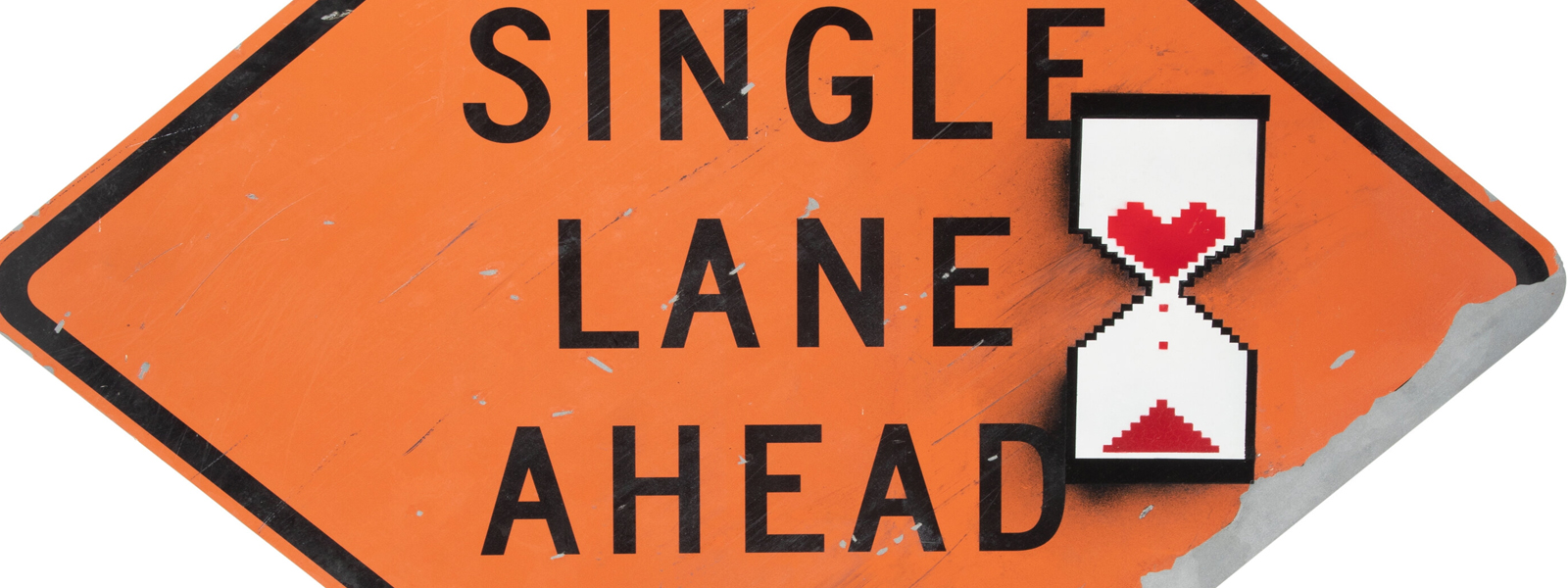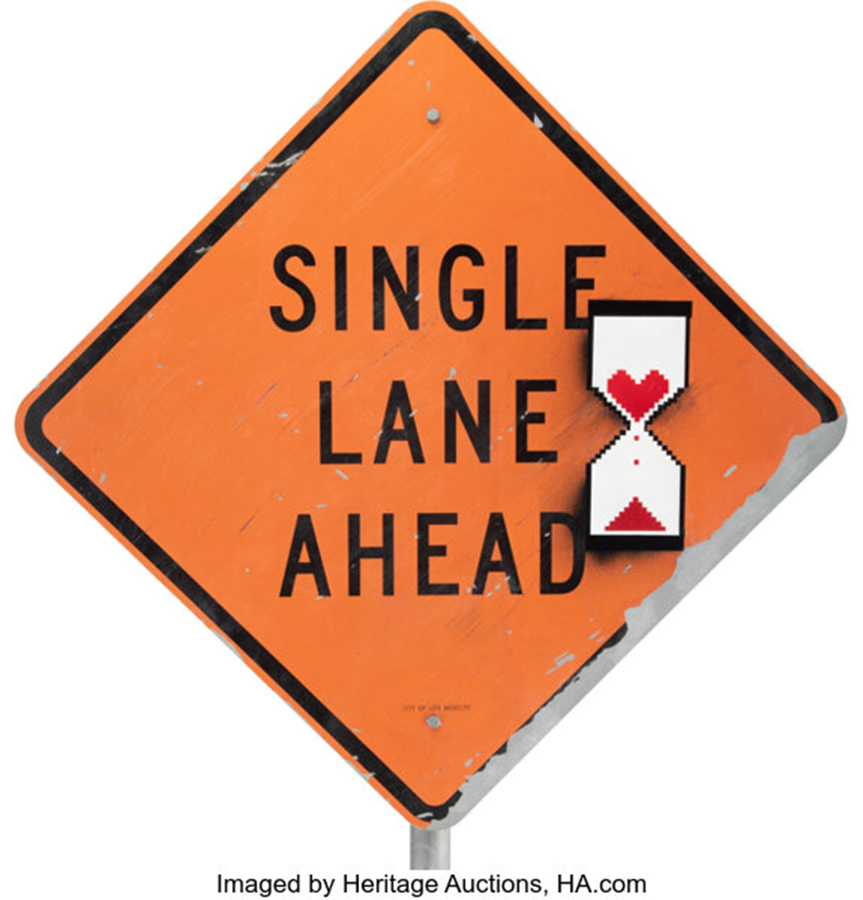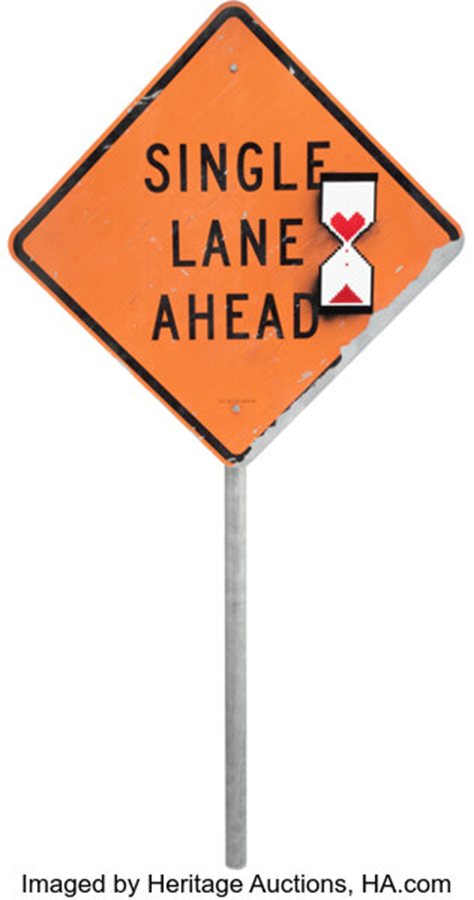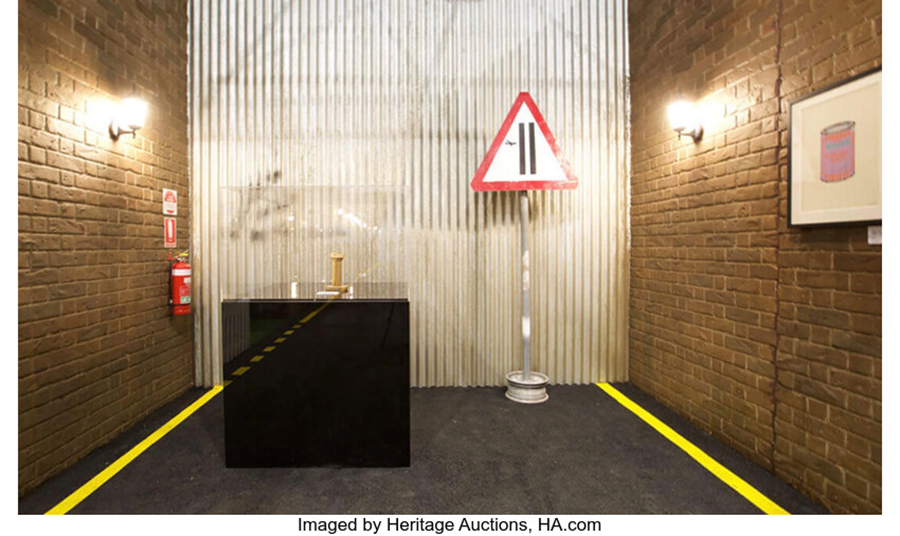THE ELUSIVE ARTIST CONTINUES TO CAPTIVATE WITH HIS SYMBOL-RICH WORKS, INCLUDING TWO UNIQUE STREET SIGNS HEADED TO AUCTION MARCH 30
By Christina Rees
In the 1980s and early ’90s, one of the most common discussions in the art world was whether or not street art – aka graffiti (aka Urban Art) – belonged in institutions, galleries and private collections. The question focused on relocation: Would transferring a would-be temporary work from the “wild” to a clean, well-lighted place have a neutralizing, or even castrating, effect on the work (if not the artist’s intentions)? Could Urban Art maintain its impact or credibility if it’s displayed, bought and sold alongside more conventional studio-made artworks?
Then came Banksy, whose explosive success changed the course of the Urban Art market.
Which is not to overlook the importance of Keith Haring or Kenny Scharf or DAZE (or, later, Shepard Fairey), let alone the most famous artist who ever made the crossover feel completely organic and inevitable: Jean-Michel Basquiat. Those earlier discussions took place because these complicated artists defied labels and took advantage of a system that was more than ready to reward them. Street art was showing up on gallery walls whether we were ready for it or not.
But Banksy’s arrival on the scene in the 1990s seemed to sunset the conversation altogether, because the pseudonymous UK-based artist’s work made him a household name in a way that no other street artist could claim. His pithy political and social-commentary images – painted on streets, walls, bridges and signage the world over – were understood as symbols of an entire age, an entire cultural epoch.
Banksy’s dark and often humorous (and sometimes heartbreaking) work belonged to everyone, and it also served as an event: Every new Banksy production made headlines wherever it popped up. There was no way this artist’s name wouldn’t end up in collections; he symbolized too much for him to escape the system. Spotting a new Banksy piece in the wild was akin to finding an unattended gold bar. A whole section of wall holding up a shop, adorned by a fresh Banksy stencil, could be put into play marketwise. No number of art historians or art-world cynics could stop the deluge of global interest in Banksy’s work.
Like other street artists, Banksy makes editioned works for the commercial market; that’s been a natural profit-generating move for so many of those we consider “urban artists.” But Banksy’s one-of-a-kind works are still by far the artist’s most significant and covetable (a limited number are sold officially and privately through a Banksy-created agency named Pest Control).
URBAN ART SIGNATURE® AUCTION 8119
March 30, 2023
Online: HA.com/8119a
INQUIRIES
Taylor Curry
212.486.3503
TaylorC@HA.com
On March 30, in its Urban Art Signature® Auction, Heritage will offer two artworks by Banksy that are wholly unique – the ultra-rare grails for Banksy collectors. Single Lane Ahead from 2011 and Warning Sign from 2006, both signed by the artist, epitomize Banksy’s graphic prowess and visual economy – his way of making urgent and complex visual statements in a few ingenious moves.
Single Lane Ahead is spray enamel on a found street sign; the pixelated hourglass bleeding out a single heart sums up an inevitable future of atomized people making their way through life with few real-world connections. You can interpret it as being about the loss of romantic love, or an advancing fate of every person fending for themselves from behind the anonymous screens that define our digital age. Banksy has a well-earned reputation for his prescience; most people in 2011 were still just getting around to the novelty of social media, while he sensed a collapse of community and an epidemic of loneliness.
The Museum of Contemporary Art, Los Angeles featured this significant piece at the seminal 2011 “Art in the Streets” exhibition curated by Jeffrey Deitch; it was the first major U.S museum survey of graffiti and street art.
“Single Lane Ahead introduced an entire generation of museumgoers to Banksy, and we are absolutely delighted to bring this important work to auction,” says Taylor Curry, Heritage’s Director of Modern & Contemporary Art in New York. “In the best of Banksy’s work, he challenges the viewer to stop, look and think beyond the canvas – or sculpture or street sign. This work is no exception and has all the hallmarks of what you want in a Banksy.”
Warning Sign is a particularly limber and dark half-jest about the messiness of geopolitics and our willful disregard of worst-case scenarios. On this street sign marked with graphic flat black parallel lines, an added jetliner in silhouette flies toward them, instantly transforming the simple lines into the World Trade Center Twin Towers. A remarkably elegant work, it was widely exhibited in Steve Lazarides’ “The Art of Banksy” touring exhibition in 2016-17.
Not only did Banksy’s work open a floodgate of interest in the Urban Art category, but it also reacquainted the public with popular art’s ability to make bracing political statements without descending into didacticism. The artist’s single-frame statements, made in pieces such as Single Lane Ahead and Warning Sign, are bold but not simple. His layered sentiments on power and class structures, corruption, desperation, hope and defiance have as much to do with where they pop up as what they depict, and yet his style is so recognizable that even when domesticated by the market, his works remain shot through with the lyricism that made them so memorable and desirable in the first place. Once a Banksy, always a Banksy – no matter where you spot it.
 CHRISTINA REES is a staff writer at Intelligent Collector.
CHRISTINA REES is a staff writer at Intelligent Collector.






